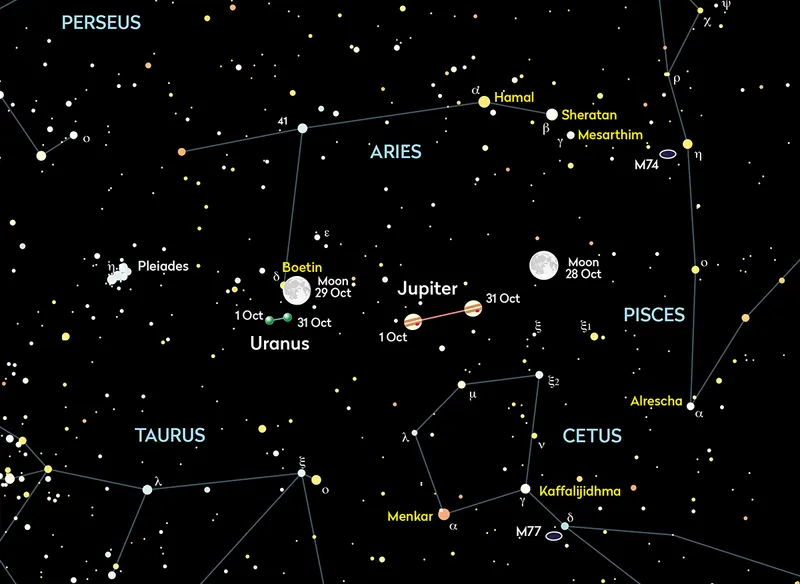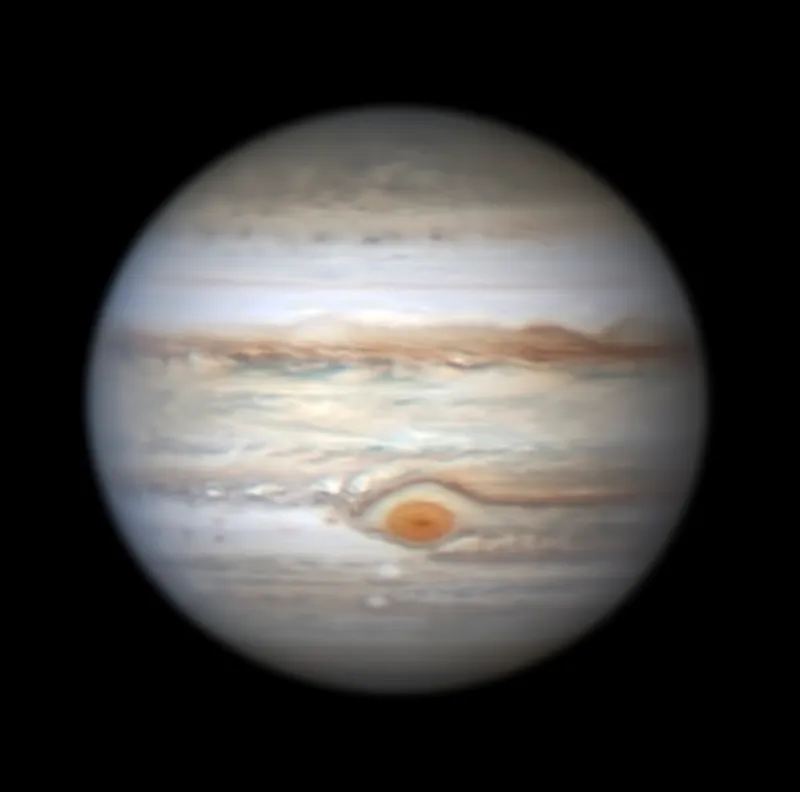Jupiter reaches opposition on 3 November 2023, and throughout October is well-placed for observing.
From the UK, it’s able to reach its highest position, around 51° up when due south, under truly dark skies.
It’s also very bright, shining at mag. –2.8. Consequently, it’s a great time to observe and image this amazing world.
In this guide we'll reveal what you'll see as you observe Jupiter during October, what you can expect as it nears opposition, and what the other planets are doing this month.
For more advice, read our guide on how to observe Jupiter through a telescope

Jupiter through a telescope
Through a small telescope, Jupiter’s disc is obvious and appears squashed.
Being a gas planet and rotating rapidly in under 10 hours, Jupiter’s equatorial regions bulge and give the planet its oblate appearance.
Give your eyes time to adjust to the view, and you'll be able to see much more.
The first detail you’ll see on Jupiter's disc will be the two dark belts that run either side of and parallel to the equator.
These are the north equatorial and south equatorial belts (NEB and SEB).

Other belts and zones are also visible, becoming easier with greater aperture and steady skies.
Jupiter’s atmosphere can appear complex and it’s not always that easy to see the demarcation between the smaller belts and zones.
The famous Great Red Spot (GRS) is embedded within the SEB in a scalloped region known as the Great Red Spot Hollow.
Its visibility depends on when you observe the planet.
With its rapid rotation period, the GRS may be visible or may be around the other side of the planet.
Freeware applications such as WinJupos can tell you when it will be visible.
In addition to the rich, detailed atmosphere, Jupiter’s four largest moons put on a regular show as they appear to interact with the planet.
Observing the planets, October 2023

Jupiter
- Best time to see: 1 October, 00:15 BST (30 September, 23:15 UT)
- Altitude: 51°
- Location: Aries
- Direction: South
- Features: Complex atmosphere, Galilean moons
- Recommended equipment: 75mm or larger telescope
Mercury
- Best time to see: 1 October, 40 minutes before sunrise
- Altitude: 7° (low)
- Location: Virgo
- Direction: East
Mercury is a mag. –1.0 morning planet on 1 October, rising 90 minutes before sunrise. As October progresses, it moves closer to the Sun, brightening as it goes. On 7 October it’s at mag. –1.1, rising one hour before the Sun.
The Sun’s glare engulfs the planet rapidly after this date. Superior conjunction occurs on 20 October, after which Mercury returns to the evening sky, when it’ll be poorly positioned after sunset, setting with the Sun.
Venus
- Best time to see: 24 October, from 06:00 BST (05:00 UT)
- Altitude: 22°
- Location: Leo
- Direction: East-southeast
Venus is a bright morning planet. Shining at mag. –4.4, it reaches greatest western elongation on 24 October, separated from the Sun by 46.4°. On 10 October, it’s joined by a 17%-lit waning crescent Moon and lies 2.3° from Regulus (Alpha (α) Leonis). At the start of the month, it rises 4 hours before sunrise and is visible against astronomically dark skies for around 2 hours. This figure increases towards the end of October, Venus rising 4.5 hours before the Sun and visible in true darkness for 2.5 hours.
Through the eyepiece on 1 October, Venus appears 36%-lit and 31 arcseconds across. On 31 October its phase increases to 54%-lit, its apparent diameter now 22 arcseconds. Its 50%-lit phase (dichotomy) should occur at greatest western elongation, but will be a few days late due to the phase anomaly.
Mars
Not visible this month
Saturn
- Best time to see: 1 October, 22:50 BST (21:50 UT)
- Altitude: 24°
- Location: Aquarius
- Direction: South
Saturn is well-placed in the evening sky, appearing at 24° altitude from the centre of the UK when due south. It appears like a mag. +0.5 off-white, yellowish star at the start of October, dimming to mag. +0.7 by the end of the month. A bright, waxing gibbous Moon appears near Saturn on the evenings of 23 and 24 October.
Uranus
- Best time to see: 31 October, 02:50 UT
- Altitude: 55°
- Location: Aries
- Direction: South
Uranus now reaches its best position, due south, under astronomically dark skies. At mag. +5.7, it will reach opposition next month, but being such a distant world, this doesn’t change its appearance a great deal.
By the end of October, the planet brightens to mag. +5.6 and presents a disc nearly 4 arcseconds across. On 31 October it sits 2.2° south-southeast of mag. +4.3 Botein (Delta (δ) Arietis).
Neptune
- Best time to see: 2 October, 00:15 BST (1 October 23:15 UT)
- Altitude: 34°
- Location: Pisces
- Direction: South
An evening planet, favourably placed, Neptune reaches a peak altitude of 34° under dark sky conditions all month. It currently shines at mag. +7.9.
This guide originally appeared in the October 2023 issue of BBC Sky at Night Magazine.
